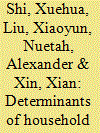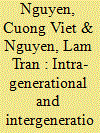| Srl | Item |
| 1 |
ID:
094661


|
|
|
|
|
| Publication |
2010.
|
| Summary/Abstract |
This article uses multivariate regression and decomposition analyses to assess household income mobility determinants and their contributions to income mobility in rural China from 1989 to 2006. The findings indicate that households with lower initial income level, higher share of wage income, higher educational level of household members, larger number of non-agricultural employed household members and younger heads are more mobile. Moreover, besides initial income, change in the share of wage income, change in the share of non-agricultural employed household members, and change in average year of education of household members are the most important factors that account for income mobility. These findings necessitate more emphasis on policies that promote non-agricultural employment and education to enhance household income mobility in rural China.
|
|
|
|
|
|
|
|
|
|
|
|
|
|
|
|
| 2 |
ID:
147440


|
|
|
|
|
| Summary/Abstract |
This paper analyzes theoretically and empirically the impact of intergenerational transmission of human capital on the income mobility in China. We use a three-period overlapping-generations (OLG) model to show that the human capital transfer plays a remarkable role in determining the parent-to-offspring investment in human capital and the intergenerational elasticity of income. We then estimate a simultaneous equations model (SEM) using the 1989–2009 China Health and Nutrition Survey (CHNS) data to verify our theoretical predictions. The results show that (i) human capital, measured by health and education, is directly transmitted from one generation to the next, reflecting the parent-induced inequality of development opportunities among offspring in China; (ii) the estimated intergenerational income elasticity increases from 0.429 to 0.481 when the direct transfer of human capital is accounted for, suggesting that omitting this mechanism would overestimate China's income mobility. Our findings provide policy implications on strengthening human capital investments among the disadvantaged groups, reinforcing reforms that promote equality of opportunity, and improving the efficiency of labor markets in China.
|
|
|
|
|
|
|
|
|
|
|
|
|
|
|
|
| 3 |
ID:
173785


|
|
|
|
|
| Summary/Abstract |
This study examines intra-generational and intergenerational mobility of employment and income in Vietnam during the 2004–2014 period. It finds there was high mobility across occupations but less mobility across wage-job employment and economic sectors. Upward labour mobility increased over time because of the increase in skilled occupations. The intergenerational elasticity of earnings is estimated at around 0.36. Education plays an important role in increasing intra-generational as well as intergenerational mobility. The earning intergenerational elasticity for children with less than primary education is rather high, at 0.51, while this intergenerational elasticity for those with a college or university degree is much lower at 0.17.
|
|
|
|
|
|
|
|
|
|
|
|
|
|
|
|